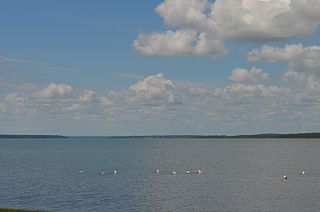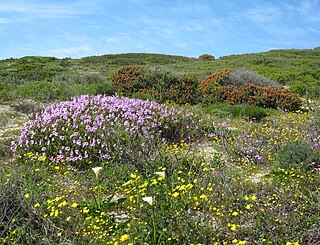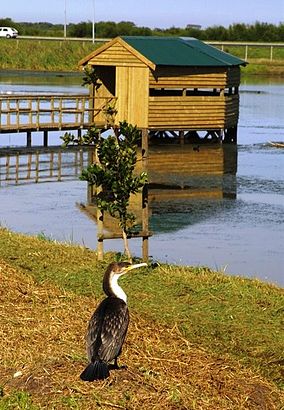
The Rondevlei Nature Reserve is located in Grassy Park, Zeekoevlei and Lavenderhill, suburbs of Cape Town, South Africa. The bird sanctuary covers approximately 290 hectares of mostly permanent wetland and consists of a single large brackish lagoon. The nature reserve is among the most important wetlands for birds in South Africa despite being situated directly alongside the Zeekoevlei. A number of islands on the vlei act as vital breeding sites. Rondevlei is home to about 230 bird species, a variety of small mammals and reptiles like caracal, porcupine, Cape fox, grysbuck, steenbuck and mongoose, as well as a hippopotamus population which was re-introduced in 1981 as a means to control an alien grass species from South America, which had covered the shoreline and was threatening to engulf the vlei itself. It boasts unusual and threatened ecosystems like strandveld, sand plains fynbos, Cape lowland wetland vegetation and indigenous coastal fynbos vegetation with unique plants found nowhere else in the world.

The Cape Floristic Region is a floristic region located near the southern tip of South Africa. It is the only floristic region of the Cape Floristic Kingdom, and includes only one floristic province, known as the Cape Floristic Province.

False Bay Park, a Ramsar site wetland since 2015, is a nature reserve that protects the western shores of the freshwater bay, False Bay, and is situated near the coast of northern KwaZulu-Natal, South Africa. False Bay is connected to Lake St. Lucia and both are included in the iSimangaliso Wetland Park.. It covers 1,500 hectares and is located at 34° 4′ S, 18° 30′ E.

Rondebosch Common is an open common of about 40 hectares in Rondebosch, Cape Town in South Africa. A common is defined as "A piece of open land for public use, esp. in a village or town." It contains one of the only surviving pockets of the critically endangered “Cape Flats Sand Fynbos” vegetation type, which exists nowhere else in the world.

The Milnerton Racecourse Nature Reserve is a lowland conservation area located in the City of Cape Town, South Africa.

The Diep River Fynbos Corridor is a nature reserve located in the Blaauwberg region of Cape Town, South Africa. It forms part of the larger Table Bay Nature Reserve, which was established in June 2012.

Cape Flats Dune Strandveld is an endangered vegetation type. This is a unique type of Cape Strandveld that is endemic to the coastal areas around Cape Town, including the Cape Flats.

Cape Flats Sand Fynbos (CFSF), previously known as Sand Plain Fynbos, is a critically endangered vegetation type that occurs only within the city of Cape Town. Less than 1% of this unique lowland fynbos vegetation is conserved.

Mamre Nature Garden is a 254-hectare (630-acre) nature reserve in Cape Town, South Africa, located on the city’s northern outskirts. The reserve has a high degree of biodiversity and preserving the endangered Atlantis Sand Fynbos vegetation type and the plants and animals that live in it. In addition, the reserve has an important cultural history.

Kenilworth Racecourse Conservation Area is a 52-hectare (130-acre) nature reserve, situated in the centre of Kenilworth Racecourse, in Cape Town, South Africa. Due to its location, it has been left undisturbed for more than 100 years, making it now the best preserved patch of “Cape Flats Sand Fynbos” in the world.

Zandvlei Estuary Nature Reserve is a 300-hectare (740-acre) nature reserve and recreational area located in Cape Town, South Africa.

Meadowridge Common is an 8-hectare (20-acre) reserve in the Meadowridge suburb of Cape Town, South Africa, which preserves a fragment of critically endangered Cape Flats Sand Fynbos vegetation.

Witzands Aquifer Nature Reserve is a 3,000-hectare (7,400-acre) protected natural area in Cape Town, South Africa, located on the city’s northern outskirts. This reserve protects an important part of Cape Town’s natural and cultural heritage, including the Atlantis Aquifer.

Wolfgat Nature Reserve is a coastal nature reserve in Mitchells Plain on False Bay in the Western Cape, South Africa.

Bracken Nature Reserve is a 36-hectare (89-acre) piece of protected land in Brackenfell in the Western Cape, South Africa.

Durbanville Nature Reserve is a 6-hectare (15-acre) piece of protected land, located next to the Durbanville Racecourse in the Western Cape, South Africa.

Harmony Flats Nature Reserve is a 9-hectare (22-acre) piece of protected land, located between Strand and Gordon's Bay, South Africa. It protects a surviving fragment of critically endangered Lourensford Alluvium Fynbos vegetation.

Blaauwberg Nature Reserve was proclaimed a local and provincial nature reserve in 2007. The reserve has views down fynbos slopes, across the city, to seven kilometres of rocky and sandy coastline and the ocean and beyond. The reserve presents itself as one of the few viewpoints in the world from where you can see two proclaimed world heritage sites, namely Table Mountain and Robben Island.

Macassar Dunes Conservation Area is a 1,116-hectare (2,760-acre) coastal nature reserve in Macassar, within the City of Cape Town, South Africa.














